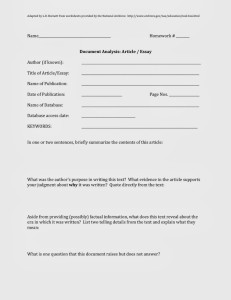Last summer, I taught the second half of the survey (in my university system, that’s “U.S. since 1865”). The summer session was one of those lightning-round, five-week sprints. This semester I am proceeding at a more normal pace, again teaching the second half.
I adopted/adapted a primary source analysis assignment that I have found to work very well in both the accelerated summer course and the semester-long course, and I thought I would share it with TUSH readers.
The National Archives (which is, as of this writing, back online despite the government shutdown) hosts a “DocsTeach” online resource providing U.S. history teachers with suggestions for incorporating archival material into lectures. As part of that program, they provide downloadable PDF “Analysis Sheets” for a variety of archival materials, from texts to artifacts to sound recordings.
I have adapted a couple of these worksheets for my students’ homework assignments. Here are my analysis worksheets for “articles / essays” (basically, the editorial content of newspapers and magazines) and for advertisements. (I had to upload these as .JPG files, but they should convert okay back to .PDF)
For each homework assignment, I set a date range. Students then browse or search through pre-selected archives — Harper’s Weekly, McClure’s, Ladies Home Journal, LIFE, Time — and select a text to analyze using the worksheet. I encourage them to select texts that are related in some way to a particular area of interest that might serve as their paper topic. So their homework doubles as archival research for their papers. (More on that later.)
Over the summer, during those four-and-a-half hour lecture blocks, I had plenty of time to ask a few student volunteers each class meeting to lead us through their source selection and analysis. I would call up their document from the online archive using the date / page information they provided, and then we would all look at the source together.
This kind of impromptu group discussion works better with advertisements than it does with narratives or news reports. However, you could also ask a student or a group of students to provide the class with the bibliographic information for the source they analyzed so that everyone has a chance to view it prior to class discussion.
At the end of class, students hand in their source analysis sheets, and I read and comment on them, raising additional questions that might help students dig more deeply into their sources or connect their own research to the lecture materials. The idea is to get students accustomed to looking at texts not just as containers of facts from or about the past but as (sometimes inadvertent) expressions of meaning.
Advertisements are great for looking at both intentional and inadvertent meanings; in my next post, I’ll talk more about the delights and dangers of assigning advertisements as primary sources.


I have never taken the time to so carefully walk my students through the process of critically evaluating primary sources. I think I take for granted their ability to think like a historian. I really like the idea of using this as a scaffolding exercise–requiring them to fill it out at the beginning of the semester and then shifting the assignment to brief writing reflections or short oral presentations. I really like the way you have the students present on their sources. Do they know which day they will have to present their document, or do you surprise a few different students at random throughout the semester? I could so both approaches as having advantages.
I’m looking forward to hearing more about how you use advertisements!